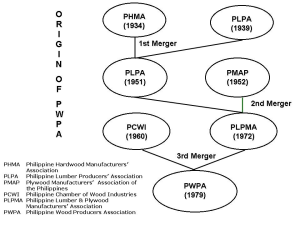PWPA – Its History
The Philippine Wood Producers Association (PWPA) is the result of a series of mergers of six predecessor-in-interest organizations. The founding year of PWPA was reckoned from 1951 when the surviving organization of the earlier merger, the Philippine Lumber Producers’ Association (PLPA), was registered with the Securities and Exchange Commission (SEC) on May 30, 1951. The charter of PLPA was carried by PWPA.
It is a fact, however, the first predecessor-in-interest of PWPA was the Philippine Hardwood Manufacturers’ (Exporters) Association (PHMA), founded in 1934 on the eve of the American Civil Government in the country, but was not officially registered with the government. Initially established by a small group of American wood-based companies operating in the country, the main aim of PHMA was to introduce the hardly-known but widely available local timber species it named Philippine Mahogany in the US market. Closely supported by its counterpart in the US mainland, the Philippine Hardwood Manufacturers’ (Importers) Association, the Philippine-based association was successful in making known and accepted the Philippine Mahogany lumber to the US, and much later, to the world market.
in the country, the main aim of PHMA was to introduce the hardly-known but widely available local timber species it named Philippine Mahogany in the US market. Closely supported by its counterpart in the US mainland, the Philippine Hardwood Manufacturers’ (Importers) Association, the Philippine-based association was successful in making known and accepted the Philippine Mahogany lumber to the US, and much later, to the world market.
On October 9, 1939, the PLPA was organized by practically the PHMA group with the objective of unifying local lumber manufacturers and promoting wider use of lumber in the domestic market. Before their merger, the PHMA and PLPA existed side by side, the PHMA took care of the export trade and the PLPA, the domestic trade.
The Japanese occupation of the Philippines made inactive these associations. The Japanese established the Philippine Lumber Control Union (Philippine Mokusai Kumlai), a monopoly to control logging, sawmilling, and supplying lumber to the Imperial Japanese Forces. In answer to the complaints about prices and payments of logs and lumber, the Filipino companies belonging to the 37 provincial and regional associations consolidated themselves on September 7, 1943 into the Forest Products Producers Federation. All members sold their produce to the Federation who, in turn, sold it to the Japanese Military Forces.
As the war ended in late 1945 and the Second Republic proclaimed on July 4, 1946. the wood industry was made active by the requirements for wood materials needed for the reconstruction of the country. On June 8, 1949, in a joint meeting of PHMA and PLPA, a Resolution to merge was adopted with the PLPA as surviving association.
Sometime in 1952, the few plywood companies organized the Plywood Manufacturers’ Association of the Philippines (PMAP). It was only after the War that plywood manufacturing gained some headways. The aim was to encourage the processing of logs into value-added plywood for export. Also sometime in 1960, Philippine Chamber of Wood Industries (PCWI) was organized with the objective of promoting the increase in the production and marketing of timber and timber products.
The period of 60’s and 70’s saw the phenomenal growth of the wood industry. The wood industry became the second biggest foreign exchange earner and was instrumental in realizing a favorable balance of trade and dollar reserves for the country.
On June 25, 1972, with a commonality of objectives, the PLPA and PMAP merged assuming the name of the latter.
On December 22, 1979, in the face of growing competition from other tropical countries, particularly those from the SE Asian Region and in the desire of the government to rationalize the wood industry, i.e, to shift from log export to processing, the PLPMA and the PCWI merged adopting the charter of the former and calling itself the Philippine Wood Products Association (PWPA), renamed later as the Philippine Wood Producers Association (also, PWPA acronym). The rest is history.
